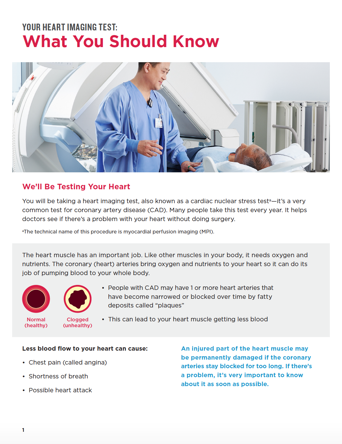Questions Patients May Ask
Questions Patients May Ask
Addressing Potential Questions About Nuclear Stress Testing
Below are some questions patients may have about myocardial perfusion imaging (MPI) and potential answers that you might consider when talking to your patients about nuclear stress testing. Also, below are links to patient resources that you can download to help answer questions about MPI and inform patients about how to properly prepare for a stress test.
Patients who are undergoing MPI may want to know what the test is and why it is necessary. They might feel reassured knowing that MPI is a common, noninvasive test that shows how well the heart muscle is pumping and how well blood flows through the heart muscle. An MPI test compares blood flow during exercise on a treadmill or exercise bicycle to blood flow while at rest. If a patient can’t exercise well, they’ll get a medicine to increase the blood flow to their heart muscle as if they were exercising. MPI is a useful test that can tell if the heart arteries have narrowed or are blocked, which may be a cause of chest discomfort.1
Patient Heart Imaging Test Guide
To help answer this question, this guide offers information that can help patients understand the nuclear stress test process. Helping patients feel better prepared and know what to expect before their test can help reduce patient anxiety and improve the cardiac testing experience.
A nuclear stress test is often performed by having the patient exercise on a treadmill or exercise bicycle to increase their heart rate. Patients may want to be informed ahead of time that they will receive an intravenous injection of a radiotracer during the procedure so they are not surprised on the day of the test.1

Patients can also visit Mind Your Heart Facts for more information about how a nuclear stress test is performed.
Patients who are concerned about being able to exercise adequately can be informed that pharmacologic stress may be used instead of the treadmill. The “chemical” stress test can simulate exercise by increasing blood flow to the heart. If the test shows a lack of blood flow during exercise or stress, but is normal at rest, it could mean that an artery that carries oxygenated blood to their heart is narrowed or blocked.1,2
Patients may want to know that the test should take between 2 and 4 hours, or more than 1 day, depending on the protocol.1,2 This will help them know how much time to allow so they can plan accordingly.
In order to help improve the patient experience and potentially avoid canceled tests, providers may want to inform patients of what they should do and what they should avoid before a nuclear stress test. Providing them with a list of foods, drinks, and medications to avoid 24 hours before the test can help them better prepare.1 Informing patients about what to expect during the test may also help them to plan ahead.
Patient Test Prep Checklist
This resource provides patients with a checklist of things they should and shouldn’t do before the nuclear stress test. It includes a partial list of things your patients should not eat or drink prior to their test, as well as some medications to avoid, so they can arrive for their test feeling more confident and better prepared.
A nuclear stress test shows a blockage that prevents the heart muscle from getting an adequate supply of oxygenated blood during activity.1 Patients may want to know that MPI tests show whether or not there is narrowing or blockage in the arteries of the heart. If there is blockage, further testing may be necessary to determine the best course of action.
Going over the risks and benefits of the test helps to inform patients. For example, patients should be aware that they will be exposed to a low dose of radiation. According to the appropriate use criteria (AUC), an appropriate test is one in which the expected benefits outweigh the risks.3
You might explain that the test results will show how well blood is flowing through the heart. A lack of blood flow could mean that arteries to the heart have narrowed or are blocked. Results could also show that there is scarring on the heart muscle that may have resulted from a previous heart attack. This information helps determine the best course of treatment.1
Inform patients about any safety procedures and requirements before they arrive so they know what to expect.
References+
1. American Heart Association. Myocardial perfusion imaging test (08-18-2023). https://www.heart.org/en/health-topics/heart-attack/diagnosing-a-heart-attack/myocardial-perfusion-imaging-mpi-test. Accessed 12-04-2023. 2. Dorbala S, Ananthasubramaniam K, Armstrong IS, et al. Single photon emission computed tomography (SPECT) myocardial perfusion imaging guidelines: instrumentation, acquisition, processing, and interpretation. J Nucl Cardiol 2018;25(5):1784-846. 3. Winchester DE, Maron DJ, Blankstein R, Chang IC, Kirtane AJ, et al. ACC/AHA/ASE/ASNC/ASPC/HFSA/HRS/SCAI/SCCT/SCMR/STS 2023 multimodality appropriate use criteria for the detection and risk assessment of chronic coronary disease. J Am Coll Cardiol 2023;81(25);2445-2467.


